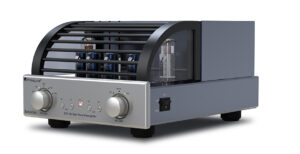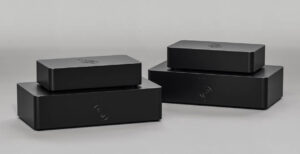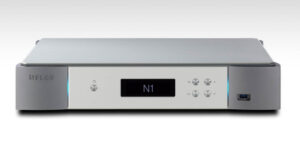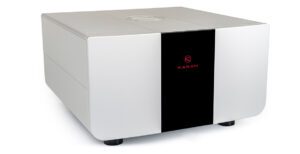
Early last year, at the CanJam SoCal event, I met up with a spokesperson from Warwick Audio Technologies—a spin-off from the University of Warwick in Coventry. What Warwick Audio Technologies had created, the gentleman explained, was an entirely new way of making electrostatic headphone drive units. The technology was called HPEL, which stands for High-Precision Electrostatic Laminate. The benefits of HPEL, I was told, included the capability for producing light and highly responsive electrostatic drivers in large multi-layer sheets from which multiple drivers of virtually any desired size or shape could be cut and trimmed. Better still, the HPEL production methodology afforded exceptional driver-to-driver consistency and uniformity—something not easily achieved with conventional electrostatic driver manufacturing techniques.
Warwick Audio Technologies did not intend to manufacture electrostatic headphones, per se, but rather hoped to license its technology to someone who would appreciate the technical and sonic benefits of HPEL and who would be able to bring an HPEL-based headphone system to market in an effective way. That ‘someone’ turned out to be Sonoma Acoustics, a Colorado-based firm led by a group of the same technical visionaries who originally helped launch the high-resolution SACD disc format and its corresponding DSD digital audio file format. The leader and General Manager of Sonoma Acoustics is none other than David Kawakami—a man whose name is, in many high-end audio circles, almost synonymous with high-res audio. For now, Sonoma’s focus is on the successful launch of its newly released Model One electrostatic headphone system ($4,995 or £4,595), which is the subject of this review. But, don’t be surprised if you see the Sonoma Acoustics team launching other kinds of audio products in the future.

The Sonoma Acoustics’ Model One electrostatic headphone system is a turnkey high-resolution music playback system that includes not only an electrostatic headphone (based on Warwick’s HPEL technology), but also a matching, purpose-built electrostatic headphone energiser/DAC/ADC/DSP module. What are the ADC and DSP elements for, you ask? The answer is that the Sonoma team wanted to give the Model One headphones a very specific “modified pseudo-diffuse field” frequency response curve and needed to apply digital signal processing to make this possible. But, they also wanted to make sure that the Model One’s energiser module could accept both digital and analogue inputs. So, the purpose of having an analogue-to-digital converter on board is to allow incoming analogue signals to be digitised on arrival, facilitating downstream DSP processing later on. One point prospective Sonoma buyers should therefore bear in mind is that the Model One headphones work only with their companion energiser/DAC/ADC/DSP module and vice versa.
The Model One headphones use Warwick-developed, low mass, single-ended (as opposed to push-pull) HPEL electrostatic drivers. In essence, each driver consists of a three-layer ‘sandwich’ comprising a stainless steel mesh grid that faces the rear side of the ear cup, a centrally-positioned open-cell insulating spacer made of Formex™ (a type of polypropylene), and then a machine-tensioned, 15μm-thick, flexible film laminate diaphragm that faces the front (or ear) side of the ear cup. The diaphragm is made of bi-axially oriented propylene film (BOPP) with a vapour deposited aluminium surface sealed with a synthetic lacquer. This entire three-layer ‘sandwich’ is then clamped within a cassette-like two-piece protective frame made of 40% glass-filled polyphenylene sulphide (PPS) from which the driver is isolated by precision-made PORON™ microcellular urethane foam gaskets.
Sonoma describes the operation of the driver as follows: “When the audio signal is superimposed on a 1350 V DC bias voltage, the ‘drum-skins’ formed by the flexible ‘front’ grid vibrate, producing sound.” Sonoma emphasizes that, “Unlike a traditional electrostatic panel, the sound you hear from a HPEL does not pass through a grid.” So, gaskets and protective cassette frame aside, there is nothing between the flexible film diaphragm and the wearer’s ears.
The Formex insulating spacer mentioned above, plays a critical role in the driver’s performance, because its open-cell design effectively sub-divides the surface of the flexible diaphragm into a number of small, differently dimensioned, ‘drum skin’-like cells that each have different resonant signatures. Each of the cells operates independently on an acoustical level, although all are driven in parallel on an electrical level. “As a result,” says Sonoma, “the sound from each cell combines in acoustic space, but the independent resonances average out, avoiding any large resonant peak in the audio band (as can happen with a single driver area).” Sonoma claims the driver remains linear to over 60 kHz, and that drivers are matched to within < ± 0.8 dB tolerances.

The Model One headphone, which is very light in weight, features cup housings made of injection-moulded magnesium, with a strong and flexible headband made of Nylon 12, and ear and headband pads covered in Cabretta (sheepskin) leather. Finally, the Model One gets its own custom made signal/bias voltage cable, developed in collaboration between Sonoma and Straight Wire; the cable uses silver-plated, high-purity oxygen free copper conductors, Kevlar® reinforcement threads, and offers extremely low (50 rF/m) capacitance.
The design of the Sonoma Model One energiser/DAC shows every bit as much attention to detail as the headphone does. The energiser features a single-ended, FET-based Class A amplifier capable, says Sonoma, of a “maximum amplitude of 145V (rms), which is superimposed on the 1350V DC bias.” The amp uses FET devices sourced from International Rectifier, plus very high quality passive parts from suppliers such as AVX, Bourns, Vishay, and others. The energiser provides two digital inputs (USB and coaxial S/PDIF) and two analogue inputs (a high level input via RCA jacks and a low level input through a 3.5mm mini-jack).
Powering the unit is an outboard, very high quality switch mode power supply with a fixed frequency switcher that operates at over 85 kHz. This outboard module features extensive internal filtering and is connected to the energiser via a custom made, shielded ‘umbilical cord’ fitted with Switchcraft locking connectors. Internally, the energiser incorporates multiple low-noise, high-current linear regulators, with separate regulators feeding both analogue and digital sections of the energiser, as well as high- and low-current circuit stages. The entire energiser/DAC/ADC/DSP module is housed in an enclosure milled from solid aluminium, complete with 3D wave-shaped cooling vents machined into the energiser’s top surfaces.
Incoming analogue signals are routed via separate, dynamic range-optimised paths though a high precision, 32-bit AKM ADC device, yielding a signal-to-noise ratio of greater than 120dB. Again, analogue signals are converted to digital form so that they—like digital audio inputs to the Model One—can be processed by the module’s 64-bit fixed-point DSP engine, which is implemented via a multi-core XMOS processor.
The DAC section of the Model One is based on two 32-bit stereo ESS Reference DACs, configured to yield a signal-to-noise ratio of 129dB. The DAC’s USB input accepts high-res PCM files at up to 32-bit/384 kHz rates, while also handling DSD64/DSD128 files via DoP (DSD over PCM). The coaxial S/PDIF input, in turn accepts all PCM inputs up to 24-bit/192 kHz. Finally, to keep timing straight, the energiser’s DAC section uses a Crystek ultra-low-phase noise oscillator, which produces just 82 femtoseconds of jitter.
Obviously, the Model One’s energiser/DAC module is geared to serve not only as the ideal powerplant for the Model One headphones, but also as a versatile source component capable of extracting the ‘Nth degree’ of resolution and musical nuance from DSD, PCM, and analogue audio signals.
Now that we’ve discussed the Model One system’s technical highlights, it’s time to ask the big question: How does its sound?
Right off the bat, I found myself won over by the Model One system’s deliberate ‘modified pseudo-diffuse field’ frequency response curve, which to my ears yielded wonderfully natural and uncoloured voicing. Many headphones exhibit distinctive sonic signatures, complete with certain identifiable response peaks and troughs, but the Model One is different; it consistently sounds evenly balanced across the entire audio spectrum and on all types of music. As a result, it is pleasingly ecumenical in its approach to musical genres, giving of its best on everything from Jackson Browne’s full-tilt live recording of Running On Empty [Rhino/Elektra, 24/192] on through to the most delicate passages of the late Beethoven string quartets [Cypress String Quartet, Avie Records, 24/96].
Next, I was struck by the Model One’s ability to deliver full measures of electrostatic performance in terms of resolution and transient agility, yet without any hint of the slight artificial upper midrange and treble ‘sheen’ some electrostatic designs impose. Frankly, many headphone veterans have been conditioned to think this undesirable element of ‘electrostatic sheen’ is the necessary price to be paid for the desirable qualities of ultra-high resolution and lightning-quick transient response, but the Model One shows this just isn’t so. On the contrary, the Model One proves you really can have all the good stuff, sonically speaking, without unwanted sonic side effects.
For a good example of the Model One’s unforced transparency and smooth naturalness in action, listen closely to Alison Krauss’ lead vocals and Jerry Douglas’ vivid Dobro lines on ‘Let Me Touch You For Awhile’ from Krauss + Union Station’s Live [New Rounder, DSD64]. Krauss’ voice famously strives for the ‘high, lonesome sound’ so characteristic of bluegrass music, but that on many loudspeaker and headphone-based systems comes out sounding ‘high, lonesome… and shrill’. But not so with the Model One; it treads that oh-so-fine line between resolution and redemption, showing Krauss’ voice replete with terrific treble clarity and power, but free from blaring edges and pain inducing glare. Similarly, Douglas’ Dobro is known for qualities at once incisive, and yet tinged with a gentle, melancholy tonality. Many headphones reduce the sound of Douglas’ Dobro to a jangly mess, but the Model One lets its sound ring true—a sound that has real presence and the unmistakable ‘twang’ Dobros should have, but without artificial metallic edginess.
Sooner or later, someone will ask, “This audiophile stuff is all well and good, but can the Model One’s boogie?” The answer is that they can—to a point. On the aforementioned Running On Empty, the Model One system did a great job of capturing the sheer energy and gusto of Browne’s touring band from the late 1970’s, complete with soaring lead and backing vocals, scorching guitar lines, potent percussion, and gutsy, propulsive bass licks. Let’s put it this way: If you can listen to the album’s title track and not wind up wanting to play air guitar, drums, or bass, then you’re a more self-controlled listener than I am. On high-energy material, the Model One is helped by an uncanny ability to render dynamic contrasts in a vivid way.

Moreover, the Model One system provides a quality of endlessly (but not oppressively) sharp focus, which tends to make all types of music more engaging. For an example of what I mean by ‘focus’, listen closely to the intersecting timbres of Yo-Yo Ma’s cello, Edgar Meyer’s bass, and Mark O’Connor’s violin on ‘Misty Moonlight Waltz’ from Appalachian Journey [Sony Classical, DSD64]. With the greatest of ease, the Model One delineates the overlapping voices of the three instruments, while at the same time showing how they operate together to form a musical whole greater than the sum of its parts.
Are there limits to what the Model One can do? I can think of two. First, in an absolute sense, the Sonoma system cannot play as loudly some do, which might or might not be a concern for listeners who like to listen at high volumes. Second, under extreme circumstances the system can be overwhelmed temporarily by extremely high amplitude low-bass material, such as the punishing low percussion notes heard near the beginning of ‘O Vazio’ [Jazz Kaleidoscope, Reference Recordings, HDCD], resulting in momentary audible distortion. However, the reality is that such ‘stress-test’ passages are the musical exception and not the rule, meaning that most of the time the Model One system will treat you to first-class musical reproduction on almost any kind of material.
Some headphone systems are ones you admire as reference components, while others are ones you want to spend time with purely for the joy of hearing your favourite music reproduced with power, detail, expressiveness, and nuance. Quite frankly, the Sonoma Acoustics Model One system is both, which is why I would encourage listeners to go hear this impressive system for themselves. Just be forewarned that to hear Sonoma’s Model One system in action is to want one of your very own (or at least that’s been my experience thus far).
TECHNICAL SPECIFICATIONS
- Model One headphone
- Type: Circumaural, open-back, electrostatic headphone
- Drivers: Full-range, low mass, single-ended electrostatic drivers
- Effective driver area: 3570 mm²
- Frequency response: 10 Hz–60 kHz
- Weight: 303 grams (excluding cables)
- Model One energiser/DAC
- Type: Class A solid-state electrostatic headphone energiser with built-in DAC, ADC, and DSP functions
- Inputs: One USB digital input, one coaxial S/PDIF digital input, two stereo analogue inputs (one high-level via RCA jacks, one low-level via 3.5mm mini-socket)
- Outputs: One electrostatics headphone/bias voltage output jack
- DAC: Dual mono, 32-bit/384 kHz ESS DACs with balanced outputs
- ADC: 32-bit/384 kHz AKM multi-channel ADC with balanced input buffers.
- DSP: 64-bit (double-precision) fixed-point processing at native sample rates, via multi-core XMOS device
- Digital audio formats supported:
USB: All PCM inputs up to 32‑bit/384 kHz and DSD via DoP (DSD64/DSD128)
Coaxial S/PDIF: All PCM inputs up to 24-bit/192 kHz - Device Drivers: An XMOS device driver is required when the Model One system is used in Windows environments
- Frequency response: Bandwidth > 65 kHz
- Distortion + Noise: < 0.05%
- Dimensions (H×W×D): 57 × 190 × 290mm
- Weight: 2.45 kg
- System Price: £4,595 (UK), $4,995 (US)
Manufacturer: Warwick Acoustics
UK Distributor:
Padood
Tel: +44 (0) 1223 653199
URL: www.padood.com
Tags: FEATURED
By Chris Martens
More articles from this authorRead Next From Review
See all
PrimaLuna EVO 100 phono preamplifier
- Apr 22, 2024

Reiki Audio SuperSwitch Master Pro + Servant Pro
- Mar 27, 2024

Melco Audio N1-S38 music server
- Mar 27, 2024











